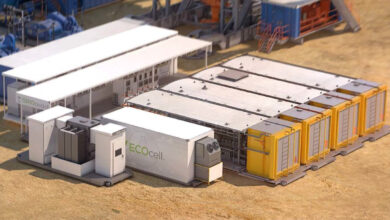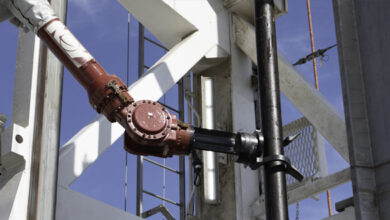Shales still name of the game on US land. In Gulf of Mexico, uncertainty reigns.
By Katie Mazerov, contributing editor
In the face of a weak offshore market, continuing low natural gas prices, a higher-than-forecasted supply of gas, and heightened regulations, logic would signal a dismal and uncertain outlook for the drilling industry in 2011. But some North American drilling contractors are enjoying an uptick in activity, a silver lining in what otherwise looks to be a cloudy picture.
Opportunities in some of the more lucrative US shale plays, made possible in part by enhanced rig designs and efficiencies, have ramped up the US land rig count to more than 1,600 rigs, which is off from the peak of 2,200 in October 2008 but considerably higher than the year-ago level of just over 1,000.
Even with the current low natural gas prices, the traditional laws of supply and demand seem to not apply to the US land rig count.

“Generally, what we would see in a sub-$4 gas market is a lot of rigs being stacked,” said John Lindsay, executive vice president, US and international operations, Helmerich & Payne International Drilling Company (H&P). “But that’s not what we’re seeing. In the last couple of quarters, the industry has actually seen another couple hundred rigs put back to work in a soft gas price environment, and we are seeing demand for new FlexRigs.”
Driving the additional rig activity and overall demand is the oil and high liquids content gas in shale plays, primarily the Eagle Ford, Cana-Woodford, the Granite Wash, a tight sand play in the northern Texas Panhandle and western Oklahoma, and the Bakken play, stretching from Canada into North Dakota and Montana. The Niobrara is also considered to hold potential, along with the Bone Spring formation in the Permian Basin of New Mexico and West Texas, Mr Lindsay noted.
Demand remains strong in the Marcellus, which has a low break-even gas price and some liquids-rich production.
“We’ve seen a real growth in our activity in liquid-rich places like the Eagle Ford, where we have four times as many rigs running than we did a year ago,” he said. “Our activity in the Marcellus has ramped up more than three times. With the level of oil and liquids being produced in the Eagle Ford play, the natural gas is the cherry on top for an operator.
“Our customers are saying that, in a lot of cases, they are drilling the wells to hold production,” Mr Lindsay continued. “But according to some of our customers, because of improved drilling efficiencies, wells are being economically drilled in a $4 gas price environment that would not have been drilled economically two years ago in a $5.50 or even $6 gas environment.”

Higher-efficiency and advanced-technology rigs that feature advanced auto-driller systems and hydraulic pipe-handling systems have been a game-changer in the industry’s increasing ability to economically drill the longer, deeper horizontal laterals required in the vast majority of shale production.
Mr Lindsay believes that after several years of retooling, the industry is now embarking on a phase where companies are replacing conventional rigs with new designs to meet the challenges of more difficult wells. “Five years ago, less than 40% of all wells in the US were being drilled directionally and horizontally,” he pointed out. “Today, more than 80% of all natural gas wells drilled are directional and/or horizontal, and more than 50% of all oil wells are directional or horizontal.”
He credits much of H&P’s increasing profile in shale drilling to the company’s AC-drive FlexRigs, which have improved efficiencies and have features that improve their environmental footprint. FlexRigs now comprise more than 80% of the company’s total fleet and, as of October 2010, 180 FlexRigs were operating, compared with 110 last year.
“We’re at 100% utilization in our FlexRigs, which are working in every major unconventional basin out there,” he said, noting that little demand is anticipated for the company’s 34 stacked conventional rigs.
H&P is building two FlexRigs per month, a positive trend following the downturn, when the cadence dropped to one per month. “We’re hopeful demand will allow us to go back to three per month in 2011,” Mr Lindsay said. H&P signed 16 multi-year term rig contracts in July.
The company is now the largest player in the Eagle Ford shale play, with 26 rigs out of a total of approximately 100 operating, and has 25 rigs in the Haynesville, 19 in the Bakken, 14 in Cana-Woodford, 14 in the Piceance, 17 in the Barnett, and 12 in the Marcellus, up from just four in that play a year ago. Mr Lindsay said the company has the personnel to meet the increased demand because H&P was able to keep the quality longer-term employees through last year’s downturn and continued to train people at its personnel development center in Houston.

He believes the newer rig designs have been a “catalyst” for other technologies, such as improved bits, motors, fluids and hydraulics, that allow for better control of downhole dynamics.
“One example – more finite control of drilling parameters has allowed both conventional and rotary steering technologies to realize improved drilling performance,” he said. “If we can control or improve wear and tear on the bit by improving the downhole dynamics, the bit is going to last longer and drill faster so the customer is able to compress well cycle times, which has been a major factor to improved field economics,” he said.
“We’ve seen a continued improvement of total cycle times in all of the major basins,” Mr Lindsay continued. “For example, three years ago in the Bakken, wells were averaging 55 days to 20,000-ft measured depth, with approximately 8,000 ft to 10,000 ft of lateral,” he said. “Today, the average Bakken well is in the 20-to-25-day range. That is a huge performance improvement that does tremendous things for the operator’s economics, especially when drilling horizontal wells, because costs are higher in the directional and horizontal part of the hole with downhole assemblies like rotary steerables and motors.”
TECHNOLOGY IS THE KEY

Ronnie Witherspoon, senior vice president, business development for Nabors Drilling USA, agrees that rig technology and automation are driving down well times and costs and have been a key factor in the heightened drilling activity in many areas. As a result of improved field economics and the increasing emphasis on the various shale plays, Nabors is operating twice as many rigs as it was this time last year, an increase from 92 in July 2009 to a current count of 186.
“Continuous drilling activity and replication of wells, like well manufacturing, is also playing an important role,” he said. “Exploitation of oil and liquids in the shale plays has substantially increased demand. We remain optimistic with respect to liquid-rich shales; however, we are cautious with respect to drilling activity driven by gas. With that said, drilling activity to hold leases should continue, and operator hedges may support a portion of the activity. We are also optimistic regarding continued development of the various resource plays where Nabors has a very large presence.”
Currently, Nabors is seeing increased activity in the Bakken, Eagle Ford and Marcellus and anticipates the Niobrara and Avalon plays to gain ground and support demand in 2011. “To support these activity increases, we have continued with our newbuild program, as well as initiated substantial rig refurbishments,” Mr Witherspoon said. “In addition, all three of our training centers are operating at expanded capacity, with emphasis on technical training at all crew levels.”

He said the company continues to emphasize pad drilling to reduce the number of wells and is introducing new HSE initiatives while maintaining ongoing HSE programs. “This is what is sustaining the culture of safety that we have developed at Nabors,” he said.
Nabors also is continuing to advance technologies and products that integrate with the company’s new and advanced rigs, such as software and automation that increase drilling efficiency and repeatability of wells, Mr Witherspoon noted.
SUSTAINABLE ACTIVITY?
Although the increased demand is good for the industry now, there is some uncertainty that the current pace of activity can be sustained beyond 2011. “Unless we see an improvement in product prices, we may be headed for a market correction where the rig count could drop as much as 15% to 20%,” said Ed Jacob, chief executive officer and president, Keen Energy Services.
“Operators have been very successful at being able to find natural gas as a result of advanced horizontal drilling and fracturing technologies,” he said. “However, we have a weak economy and few market opportunities today for natural gas. We’ve had two consecutive quarters of gross domestic product reduction. Some power plants are switching from coal to natural gas, but until we start to see some significant improvement in the market and the economy, particularly industrial demand, I see storm clouds on the horizon. I have some concerns.”
Among those concerns is Mr Jacob’s view that much of the demand through 2010 and into 2011 is due to operators drilling on leases to avoid their expiration in 2011.

“In some cases, these leases required significant investments, as much as $25,000 an acre,” he said. “And, most of these companies already have hedges in place at pretty good natural gas prices, maybe $4.50, $5 to $6, so they can afford to drill with the current economics,” Mr Jacob said.
“But there is a concern that as these hedges begin to expire between now and the end of 2011, and there are no hedges available to support additional drilling activity, the rig count will drop.”
Currently, Keen Energy has 26 rigs out of a total fleet of 38 that were built in the past four years and are currently active, primarily in unconventional shales such as the Haynesville, Fayetteville, Woodford and Barnett. Nine of the 26 working rigs have AC drive, and all have automated pipe-handling systems, top drives and enhanced high-pressure mud-handling systems. Mr Jacob projects rig activity at the company will be flat in the next 12 to 14 months as more rigs shift from gas drilling to a combination of gas and liquids.
“A year ago, there was a lot of activity in the Haynesville play because the gas was dry and the production cost was relatively low because we didn’t have to dispose of any liquids,” he noted. “That scenario has now flipped. Rigs are moving out of the Haynesville, which is predominantly gas, into plays like the Eagle Ford because it is more economically viable for companies to market the produced liquids and their gas.”
He said Keen Energy has had numerous requests to deploy rigs to the Eagle Ford play and the Permian Basin but has no immediate plans to move in that direction or add to its existing fleet.
In terms of technology, Mr Jacob agrees that after several years of advancements, current rig technology is meeting the industry’s needs. Keen Energy is also engaged in a major effort to change its safety and environmental culture. “We’re investing heavily in training, particularly leadership training, and trying to change the behavior of our employees as they go about performing their jobs on a daily basis,” he said.
“In 2011, we will begin the process of trying to determine our carbon footprint,” he added. “In the coming year, we’re going to be exposed to more government regulation and oversight than we’ve ever experienced. Our biggest concern is the potential regulatory implications on fracturing and the impact the regulations will have on shale gas economics.”
GOM: A FROZEN MARKET
Stepped-up regulations have already been mandated for deepwater drilling (See Page 40). That development, along with concern and uncertainty in the wake of the Macondo blowout, is a factor in the current weak offshore market.
“Certainly, Macondo and the ensuing moratorium has frozen one of the most important markets, and it has yet to be determined what the long-term impacts will be,” said Lawrence R Dickerson, president and chief executive officer, Diamond Offshore Drilling. “Any time something occurs in one market, it influences other markets.”
The Bureau of Ocean Energy Management, Regulation and Enforcement (BOEMRE) has released a new Drilling Safety Rules and Workplace Safety Rule, with more regulations expected.
“It is not unreasonable that certain things need to be done in the aftermath of this disaster, but the mountain of tasks, along with industry-wide caution, is going to make a full return to drilling extremely slow,” Mr Dickerson said.

“Lifting the moratorium is just one step … for energy exploration and development to proceed at a reasonable pace. I think it will take at least six months after that before we can determine what the new normal will be.” Permit approvals for jackup rigs have come at a very slow pace. Dayrates for jackup rigs have also declined.
Mr Dickerson said there is worldwide concern from customers and governmental agencies about how drilling contractors are responding to the Macondo incident and what procedures they have in place to deal with issues surrounding the blowout. “We emphasize the steps we have in place that we believe are appropriate,” he said. “In our mind, the issue is people and procedures more so than equipment failure. That is certainly how we’re addressing it. We’ve had meetings with our well control personnel from around the fleet to make sure they understand their important roles and the policies we have in place.”
Diamond had 10 rigs in the Gulf of Mexico out of a total fleet of 46 at the time of the event. The company has since relocated three of those rigs – one to Egypt, another to the Congo and a jackup rig to Brazil that had been chartered before the blowout – and cold-stacked two. Of the five rigs remaining in the Gulf, two are jackups that are coming to the end of their current wells. One semi is working on well control projects, and two semis are idle. The combined impact of idling and relocating rigs has resulted in up to 350 lost jobs at the company, Mr Dickerson noted.
He believes the impact of reduced activity in the GOM will not meaningfully disrupt oil prices and supplies, as only 2.5% of worldwide production comes from the Gulf. But because a large percentage of US natural gas comes from the GOM, the shutdown could ultimately push gas prices higher. And the moratorium will continue to disrupt employment, he said. “Over time, the nation is at risk of losing an industry that the United States dominates because, as more rigs go overseas, the Gulf becomes less and less important. There will be lower employment here and fewer people to promote into management positions.”
Despite the uncertainty, Mr Dickerson says there remains quite a bit of optimism about the offshore market and the Gulf in particular. “We have strong oil prices now, and there has not been a huge exodus from the Gulf,” he said. “Rigs are standing by, and operators remain excited about the prospects in the Gulf of Mexico. They have lost some time, and they would like to get back to work when the regulations permit.
“If people want safe, offshore development and exploration to continue, and I believe they do, it seems to me the system will somehow evolve to permit that.”




